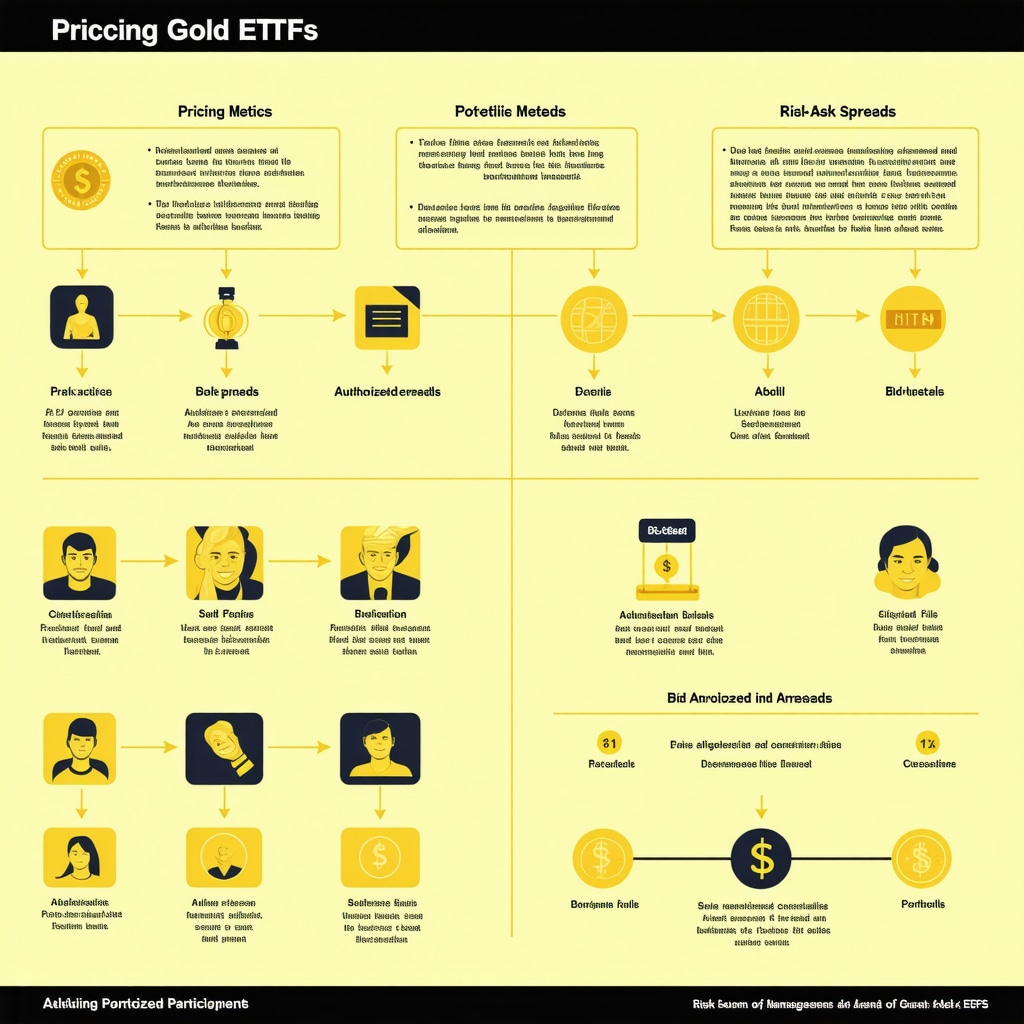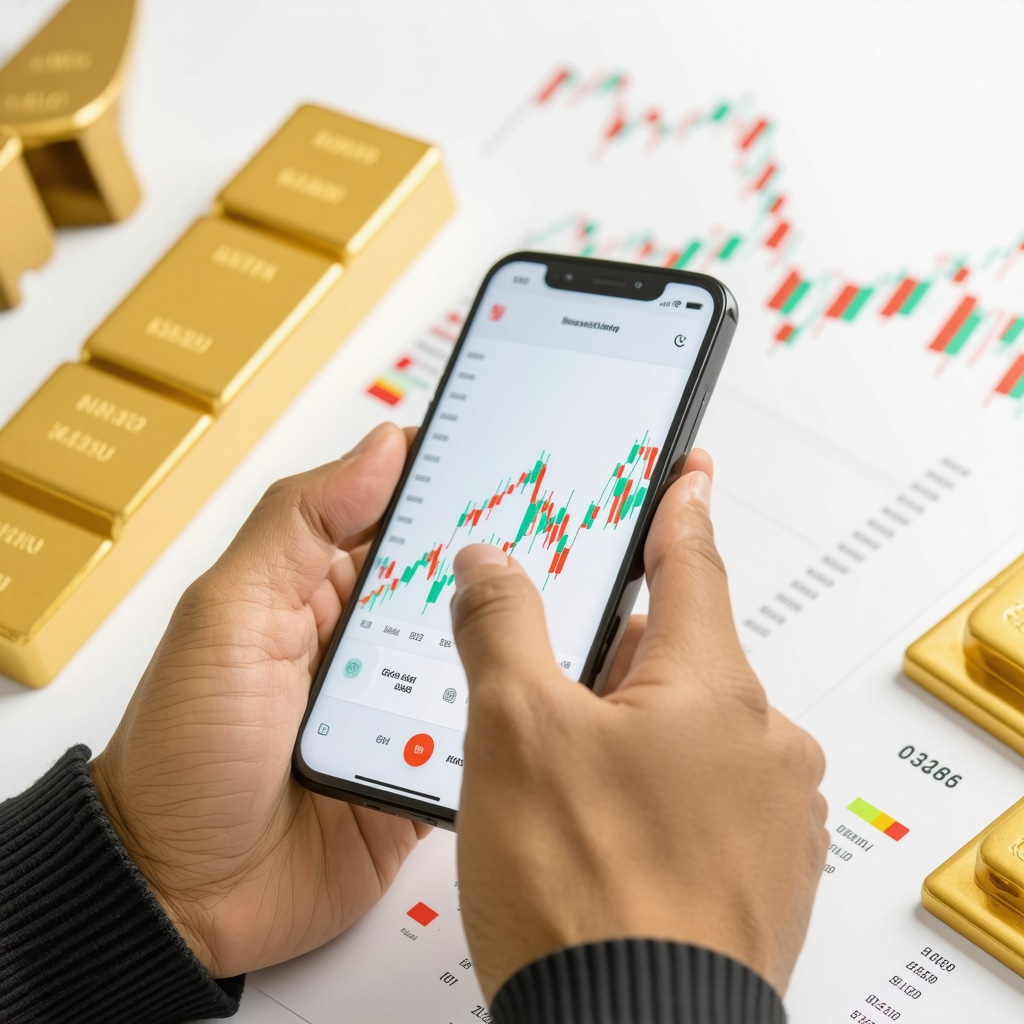Unlocking the Golden Gateway: Why Gold ETFs Are Your Beginner-Friendly Investment
Gold has long been revered as a symbol of wealth and a reliable store of value, especially in times of economic uncertainty. For beginners venturing into investment, gold exchange-traded funds (ETFs) offer a convenient, liquid, and cost-effective way to tap into this precious metal’s potential without the hassles of physical ownership. Unlike buying gold bars or coins, gold ETFs provide exposure to gold prices via the stock market, blending the security of gold with the accessibility of equities.
Decoding Gold ETFs: What Makes Them Tick?
Unlike traditional physical gold investments, gold ETFs are funds that track the price of gold closely by holding gold bullion or related assets. When you buy shares of a gold ETF, you’re essentially investing in gold indirectly, benefiting from price appreciation or hedging against inflation. This setup eliminates concerns about storage, insurance, or authenticity, making it a streamlined option for new investors.
The Step-by-Step Journey: How to Begin Your Gold ETF Investment
Starting with gold ETFs involves a few straightforward steps:
- Choose a Reputable Brokerage: Select a platform offering access to gold ETFs with low fees and robust user support.
- Research Gold ETFs: Examine fund specifics such as expense ratios, liquidity, and underlying assets. Popular ETFs like SPDR Gold Shares (GLD) are industry benchmarks.
- Set Your Investment Goals: Understand your risk tolerance and investment horizon to decide allocation size.
- Place Your Order: Buy gold ETF shares just as you would stocks, monitoring market conditions for optimal entry.
What Are the Risks and Rewards of Investing in Gold ETFs?
Gold ETFs offer diversification and inflation hedging but come with market risks like any equity investment. Price fluctuations can be influenced by global economic factors, currency movements, and geopolitical tensions. It’s critical to understand that while gold often acts as a safe haven, ETFs do not guarantee profits and are subjected to fund management fees. For deeper insight into gold investment strategies, exploring resources like effective gold investment strategies can be invaluable.
Pro Tips: Maximizing Your Gold ETF Experience with Expert Strategies
Seasoned investors suggest diversifying your portfolio by combining gold ETFs with other asset classes. Monitoring macroeconomic indicators such as inflation rates and central bank gold purchases can provide predictive signals about gold’s trajectory. Moreover, staying updated on gold market analysis helps in timing your buys and sells effectively. To expand your knowledge on selecting the right gold ETFs, consider reviewing the complete beginner’s guide to gold ETFs.
Have you started your gold ETF journey yet? Share your thoughts or questions below to engage with a community passionate about smart investing!
For further learning, consult authoritative financial institutions like the U.S. Securities and Exchange Commission’s guide on ETFs, which offers detailed, trustworthy information on ETF investing fundamentals.
Beyond Basics: Understanding the Nuances of Gold ETF Pricing and Liquidity
While gold ETFs offer an accessible gateway into precious metals, understanding the intricacies of their pricing mechanism is crucial for maximizing investment outcomes. Gold ETFs typically track the spot price of gold closely, but minor deviations can occur due to factors such as liquidity, fund management fees, and market demand-supply imbalances. Liquidity plays a pivotal role, especially during periods of high market volatility when bid-ask spreads may widen, impacting transaction costs. Investors should monitor ETF trading volumes and premium/discount levels relative to the net asset value (NAV) to identify optimal entry or exit points.
Gold ETFs vs Physical Gold: Strategic Diversification Considerations
Integrating gold ETFs into a portfolio can complement physical gold holdings, balancing convenience with tangible asset security. While physical gold provides direct ownership and acts as a hedge against systemic risks such as counterparty default, ETFs offer superior liquidity, ease of trading, and exposure without storage concerns. An expert approach involves assessing one’s risk tolerance, investment horizon, and portfolio objectives to determine the appropriate mix. For a comprehensive comparison, see our detailed analysis on physical gold investment benefits: coins vs bars compared.
How Do Macro-Economic Indicators Influence Gold ETF Performance in 2025?
Gold ETFs are inherently sensitive to macroeconomic variables, making it essential to decode these dynamics for informed decision-making. Central bank policies, especially interest rate adjustments, heavily influence gold prices by altering opportunity costs of holding non-yielding assets. Inflation rates drive demand as investors seek protection against currency depreciation. Additionally, geopolitical tensions and currency fluctuations can spur safe-haven buying, boosting ETF valuations. According to a recent analysis by the World Gold Council, central bank gold purchases and shifts in inflation expectations stand out as key determinants shaping gold demand and ETF performance in 2024-2025. Staying attuned to such indicators enables investors to anticipate price trajectories and adjust strategies proactively.
Risk Management Strategies: Mitigating Volatility in Gold ETF Investments
Employing robust risk management techniques is paramount when investing in gold ETFs amid fluctuating markets. Dollar-cost averaging can smooth out entry points, reducing the impact of short-term price swings. Setting stop-loss orders tailored to individual risk thresholds helps preserve capital during downturns. Diversifying across different gold ETFs — for example, those focusing on bullion-backed shares and others investing in gold mining companies — can also mitigate sector-specific risks. For tactical trading approaches, our guide on gold trading techniques to profit from volatile markets offers actionable insights.
Have you experimented with blending gold ETFs and physical gold in your portfolio? What macro indicators do you prioritize when timing your investments? Share your experiences below to foster a sophisticated dialogue among knowledgeable investors.
Deep Dive into Gold ETF Pricing: Unraveling the Layers Behind Market Valuations
Gold ETFs, though designed to closely track the spot price of gold, often experience subtle pricing divergences that can significantly influence investment returns. These discrepancies primarily arise from factors such as fund management fees, market liquidity constraints, and the mechanics of arbitrage between the ETF shares and the underlying physical gold. Understanding the role of Authorized Participants (APs) is critical here; they facilitate the creation and redemption of ETF shares in exchange for physical gold, helping to keep the ETF price aligned with its net asset value (NAV). However, during periods of heightened market stress or volatility, this arbitrage mechanism may be impaired, causing the ETF to trade at a premium or discount to its NAV.
Moreover, external elements like currency fluctuations, particularly the strength of the US dollar, can indirectly impact Gold ETF prices. Since gold is globally priced in USD, investors using other currencies must account for exchange rate risks, which can amplify or dampen returns. Additionally, tax considerations tied to ETF structure—such as whether the fund is physically backed or synthetic—affect after-tax gains, a nuance that sophisticated investors must assess when optimizing portfolios.
What Are the Advanced Liquidity Risks in Gold ETFs and How Can Investors Navigate Them?
Liquidity is often touted as a key advantage of exchange-traded funds, yet gold ETFs are not immune to liquidity pitfalls, especially in turbulent markets. While daily trading volumes of popular gold ETFs like SPDR Gold Shares (GLD) generally ensure smooth transactions, extreme market conditions can widen bid-ask spreads and reduce market depth, leading to increased transaction costs and potential slippage. This is compounded by the liquidity characteristics of the underlying assets—physical gold bullion—which, unlike financial instruments, cannot be instantly liquidated without cost or time lag.
To navigate these challenges, investors should monitor liquidity indicators such as the average daily traded volume, bid-ask spread percentage, and the ETF’s premium or discount to NAV. Employing limit orders instead of market orders can help control execution prices, and staggering trades to avoid market impact is prudent in large transactions. Furthermore, diversifying across ETFs with different custodian arrangements or exposure to gold derivatives can reduce concentration risk. Comprehensive data on ETF liquidity metrics can be sourced from platforms like Bloomberg Terminal or ETF.com, providing granular insights for expert decision-making.
Integrating Gold ETFs into Sophisticated Portfolio Risk Management Frameworks
Advanced portfolio managers treat gold ETFs not merely as inflation hedges but as dynamic components within multi-asset portfolios designed to optimize risk-adjusted returns. Employing quantitative risk management tools such as Value at Risk (VaR) and Conditional VaR allows for the anticipation of potential losses under extreme market scenarios, guiding allocation size and rebalancing frequency.
Additionally, tactical asset allocation strategies may incorporate signals from macroeconomic indicators—like real interest rates, monetary policy shifts, and geopolitical risk indices—to time gold ETF exposure. Incorporating alternative risk premia strategies, such as momentum or carry in gold markets, can further enhance returns, though these require sophisticated modeling and constant recalibration.
Investors can also explore pairing gold ETFs with options strategies, including protective puts or covered calls, to manage downside risks while generating income. Such derivatives tactics demand expertise in options pricing and market behavior but can be powerful tools to sculpt portfolio risk profiles.
For a detailed exploration of these complex strategies, the CFA Institute’s research on gold in investment portfolios provides an authoritative resource, blending academic rigor with practical insights.
Have you incorporated advanced pricing analytics or liquidity assessments in your gold ETF investment approach? What risk management frameworks do you find most effective for navigating gold’s unique market characteristics? Engage with our community of experts by sharing your perspectives below.

Elevating Gold ETF Expertise: Navigating Complex Pricing Dynamics and Market Microstructure
Beyond the fundamental understanding of gold ETFs lies a labyrinth of pricing nuances shaped by market microstructure and arbitrage mechanisms. The interplay between Authorized Participants (APs), physical gold reserves, and ETF share issuance creates a sophisticated ecosystem where minute timing differences and operational frictions can lead to persistent premiums or discounts relative to the NAV. Additionally, the impact of currency volatility, particularly the US dollar’s strength, adds another layer of complexity that discerning investors must quantify when evaluating exposure and potential returns.
What Advanced Analytical Tools Can Investors Use to Decode Gold ETF Pricing Inefficiencies?
For experts seeking precision, deploying quantitative models such as cointegration analysis and Kalman filters enables the detection of mean-reverting relationships between ETF prices and underlying gold prices. High-frequency trading data, coupled with order book depth metrics, can reveal transient liquidity shocks or order flow imbalances affecting ETF spreads. Moreover, leveraging platforms like Bloomberg Terminal or FactSet provides comprehensive data sets on premium/discount trends, bid-ask spreads, and volume-weighted average prices (VWAP), empowering investors to execute trades with optimized timing and minimal slippage. These sophisticated tools not only refine entry and exit strategies but also underpin algorithmic trading frameworks tailored to gold ETFs.

Strategic Liquidity Management: Mitigating Risks in Volatile Precious Metals Markets
Liquidity risk in gold ETFs escalates during periods of systemic stress, where widening bid-ask spreads and reduced market depth can erode expected returns. Expert investors adopt a multi-pronged approach: deploying limit orders to control execution prices, staggering large trades to minimize market impact, and diversifying holdings across ETFs with varying custodian structures and derivative exposures. Understanding the custodian’s role in safeguarding physical gold and the nuances of synthetic ETFs further equips investors to assess liquidity resilience. Advanced liquidity risk metrics such as the Amihud illiquidity ratio and the Roll spread estimator provide quantitative lenses to evaluate these dynamics, essential for preserving capital during tumultuous market phases.
Integrating Gold ETFs into Quantitative Portfolio Risk Frameworks for Enhanced Resilience
Incorporating gold ETFs within sophisticated portfolio risk models transcends traditional allocation heuristics. Employing Value at Risk (VaR) and Conditional VaR (CVaR) analytics tailored to gold’s idiosyncratic volatility profiles enables calibrated exposure management. Tactical asset allocation driven by macroeconomic indicators—real interest rates, inflation surprises, and geopolitical risk indices—further refines timing and weighting decisions. Additionally, overlaying alternative risk premia strategies, such as momentum and carry, can augment risk-adjusted returns but necessitate continuous model recalibration and backtesting. Derivative overlays, including protective puts and covered calls on gold ETFs, offer nuanced risk mitigation and income generation avenues, demanding expertise in options greeks and market microdynamics for optimal implementation.
For an authoritative synthesis of these advanced portfolio integration techniques, the CFA Institute’s comprehensive research on gold in investment portfolios provides rigorous empirical analysis and practical frameworks.
Are you leveraging advanced pricing analytics and liquidity metrics in your gold ETF strategy? How have you integrated tactical macroeconomic indicators and derivative overlays to optimize portfolio resilience? Engage with our expert community by sharing your insights and strategies below to elevate collective understanding.
Frequently Asked Questions (FAQ)
What exactly are Gold ETFs and how do they differ from owning physical gold?
Gold ETFs are exchange-traded funds that track the price of gold by holding physical gold or related assets, allowing investors to gain exposure to gold’s price movements without owning the metal directly. Unlike physical gold, Gold ETFs eliminate concerns about storage, insurance, and authenticity while offering high liquidity and ease of trading on stock exchanges.
How do market conditions affect Gold ETF pricing beyond the spot gold price?
Although Gold ETFs closely follow the spot price of gold, factors such as fund management fees, liquidity constraints, premium or discount to net asset value (NAV), currency fluctuations (especially USD strength), and arbitrage mechanisms can cause minor deviations. During high volatility, bid-ask spreads may widen, impacting transaction costs and causing temporary pricing inefficiencies.
What role do Authorized Participants (APs) play in maintaining Gold ETF price stability?
Authorized Participants facilitate the creation and redemption of ETF shares by exchanging physical gold bullion, helping to align the ETF price with its NAV. This arbitrage mechanism promotes price efficiency but can be disrupted during market stress, leading to premiums or discounts on the ETF shares relative to the underlying gold value.
How can investors manage liquidity risks in Gold ETF investments?
Investors should monitor liquidity indicators such as trading volume, bid-ask spreads, and premium/discount levels to NAV. Employing limit orders and staggering large trades helps control execution prices and minimize market impact. Diversifying across different Gold ETFs with varying structures and exposures can also reduce liquidity risk during turbulent market conditions.
What advanced analytical tools are useful for expert investors analyzing Gold ETF pricing inefficiencies?
Quantitative techniques like cointegration analysis and Kalman filters can detect mean-reversion between ETF prices and gold spot prices. High-frequency trading data and order book metrics reveal liquidity shocks and order imbalances. Platforms like Bloomberg Terminal and FactSet provide comprehensive datasets on spreads, premiums, and volume-weighted average prices (VWAP) for optimized trade execution.
How do macroeconomic indicators influence Gold ETF performance in 2025?
Key macroeconomic factors include central bank policies, especially interest rate changes, inflation rates, geopolitical tensions, and currency movements. Rising inflation and increased central bank gold purchases typically boost gold demand and ETF valuations, while higher interest rates may exert downward pressure due to opportunity costs of holding non-yielding assets.
What risk management strategies are recommended for Gold ETF investors?
Dollar-cost averaging smooths out entry points and reduces volatility impact. Setting stop-loss orders safeguards capital during downturns. Diversification between bullion-backed ETFs and gold mining equity ETFs mitigates sector-specific risks. Advanced investors may employ derivative overlays like protective puts or covered calls to manage downside risks and generate income.
How can Gold ETFs be integrated into sophisticated quantitative portfolio frameworks?
Gold ETFs can be incorporated using Value at Risk (VaR) and Conditional VaR (CVaR) models to manage exposure and anticipate losses under extreme scenarios. Tactical allocation driven by macroeconomic signals and alternative risk premia strategies (momentum, carry) enhance risk-adjusted returns. Derivative strategies further refine portfolio resilience but require expert knowledge in options and market microstructure.
Are there tax considerations unique to Gold ETFs compared to physical gold?
Yes, tax treatment can vary depending on the ETF structure (physically backed vs. synthetic) and jurisdiction. Some Gold ETFs may be taxed as collectibles or capital assets with different long-term holding period benefits, influencing after-tax returns. Investors should consult tax professionals to understand implications relevant to their situations.
What are the advantages of combining Gold ETFs with physical gold in a portfolio?
Physical gold offers direct ownership, protection against counterparty risk, and tangible asset security, while Gold ETFs provide liquidity, convenience, and ease of trading. A blended approach balances these benefits, allowing investors to customize exposure based on risk tolerance, investment horizon, and portfolio objectives.
Trusted External Sources
- World Gold Council (https://www.gold.org): Provides comprehensive research on gold demand trends, macroeconomic influences, and investment insights critical for understanding gold markets and ETF performance.
- CFA Institute (https://www.cfainstitute.org): Offers rigorous academic and practical research on integrating gold into investment portfolios, risk management frameworks, and advanced trading strategies.
- U.S. Securities and Exchange Commission (https://www.investor.gov): Delivers authoritative guidance on ETF investing fundamentals, regulatory considerations, and investor protection relevant to Gold ETFs.
- Bloomberg Terminal (https://www.bloomberg.com/professional/solution/bloomberg-terminal/): Provides real-time data, analytics, and liquidity metrics essential for expert-level analysis of Gold ETF pricing, spreads, and market microstructure.
- ETF.com (https://www.etf.com): Offers detailed statistics and research on ETF liquidity, fees, and structural nuances, helping investors evaluate Gold ETF options critically.
Conclusion
Gold ETFs represent a sophisticated, accessible gateway to precious metals investing, especially for those seeking liquidity and seamless market exposure without physical ownership burdens. This article has unpacked the intricate pricing dynamics, liquidity considerations, and risk management strategies essential for mastering Gold ETF investment in 2025. Expert investors benefit from deploying advanced analytical tools, monitoring macroeconomic indicators, and integrating gold strategically within diversified portfolios using quantitative frameworks. Understanding the nuanced interplay between market microstructure, arbitrage mechanisms, and external economic factors empowers investors to optimize returns and safeguard capital amid volatility. Whether starting or refining your Gold ETF approach, applying these insights can elevate your investment acumen. Engage with our community by sharing your experiences, questions, or advanced strategies, and explore further expert content to continue enhancing your precious metals expertise.










